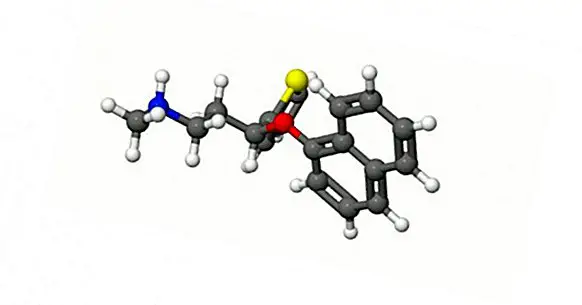Duloxetine: uses and side effects of this drug
Pharmacological science advances every day more to create increasingly effective medications with fewer side effects. One of these newly created drugs is duloxetine , which was marketed for the first time in 2004.
Throughout this article we will talk about the properties and form of action of this antidepressant , as well as the disorders in which it is administered, its side effects and the precautions that those who consume it must take into account.
- Related article: "Types of psychotropic drugs: uses and side effects"
What is duloxetine?
Duloxetine, known commercially as Cymbalta, is an antidepressant that falls within the category of Inhibitors of Reuptake of Serotonin and Noradrenaline, or SNRI. As such it exerts an effect on the levels of these two neurotransmitters, which work by regulating the mood of the people.
The good tolerance of duloxetine has made it a drug of choice for the treatment of major depression and to combat the symptomatic pain of diabetic neuropathy and fibromyalgia.
The investigations carried out around the effectiveness of this drug reveal that the usefulness of duloxetine is higher than other antidepressant drugs thanks to its double mechanism of action. Thus, it is more effective than traditional Selective Serotonin Reuptake Inhibitors (SSRIs) when it comes to encompassing and reducing the intensity of symptoms and therefore achieving a much more successful remission.
Finally, like other antidepressant drugs in this category, it also exerts a slight dopamine reuptake inhibitor effect , which makes it a fairly complete antidepressant.
- You may be interested: "Types of antidepressants: characteristics and effects"
For what disorders is it used?
The disorders and conditions in which an antidepressant such as duloxetine is administered are varied and range from psychological disorders such as major depression and generalized anxiety disorder; even physical illnesses such as pain caused by peripheral neuropathic conditions, chronic low back pain, osteoarthritis or fibromyalgia.
Further, It is also prescribed at the beginning of urinary incontinence for effort. This type of incontinence is one in which the person suffers some urine escape while doing physical activities or effort. They can also appear when you cough, lift a heavy object or make some physical effort.
In any case, the use of this drug can only be given by medical indication, and it is also essential to follow exactly the indications given by the professional.
1. Major depression
In major depression, the patient presents a symptomatology that it is characterized by a low mood , invasive and persistent. It is often accompanied by low self-esteem and anhedonia or lack of interest and joy in activities that were perceived as pleasurable before depression.
- Related article: "Major depression: symptoms, causes and treatment"
2. Generalized anxiety disorder (GAD)
This condition is distinguished by causing feelings of persistent fear and concern in the person related to any aspect of daily life. The person is completely incapable of controlling this restlessness which ends up generating other physical and psychological discomforts and interfering with the patient's daily activities .
- Related article: "Generalized Anxiety Disorder: symptoms, causes and treatment"
3. Peripheral neuropathic pain
Neuropathic pain is the product of an injury or disease that acts on the somatosensory system. Its main symptoms are: allodynia or when a harmless stimulus causes a response of disproportionate pain, and hyperalgesia or when a mild painful stimulus produces a marked pain reaction.
4. Chronic low back pain
Duloxetine has also proven to be very effective in the treatment of pain caused by chronic low back pain. This pain appears locally at the level of the lower back of the spine and must have a duration of more than three months.
5. Osteoarthritis
The pain caused by osteoarthritis is caused by a damage to the cartilage that covers the end of the bones in the joints . This causes the direct friction of the bones which causes pain, swelling and a deterioration in the movement of the joint.
6. Fibromyalgia
Fibromyalgia is a chronic condition that is distinguished by cause musculoskeletal pain in those patients who suffer from it, without it having an organic origin that justifies it.
- Related article: "Fibromyalgia: causes, symptoms and treatments"
How is this drug given?
Duloxetine is produced in delayed-release capsules to be taken orally. This means the active ingredients are not released until they reach the intestine and thus elude gastric acid in the stomach that could interfere with and spoil the effect of the medication.
The treatment will start gradually, initially administering a low dose which will be increased once a week. In the treatment of anxiety, normally the amount will be one or two daily doses. according to the patient's condition, while in the rest of the cases Doctors usually prescribe a single dose a day .
In any of the cases, the patient must follow the instructions of the doctor to the letter. In none of the cases can the patient vary the dose on their own, or take it more times than indicated.
What side effects does it have?
Like other serotonin and norepinephrine reuptake inhibitor drugs, duloxetine has a lot of side effects . However, not all are serious and are more bearable than those caused by other antidepressants. In addition, these are significantly reduced if consumed accompanied by food.
Unwanted side effects can be divided into serious and not serious. In the former, the patient should contact their doctor if they become worse or longer, while in the latter they should inform immediately.
Not serious side effects
The side effects of duloxetine that are considered less serious are the following.
- Gastric problems
- Vomiting
- Lack of appetite .
- Dry mouth.
- Problems in urination.
- Vertigos .
- Headaches
- Sweating and / or night sweating.
- Fatigue sensation
- Weakness.
- Drowsiness .
- Pain and / or muscle spasms.
- Alteration of desire and / or sexual capacity.
- Uncontrollable tremors .
Serious side effects
This psychotropic drug also has other side effects of greater severity. They are the following.
- Skin disorders and itching.
- Bleeding and / or bruising without apparent cause.
- Inflammation of the abdomen.
- Yellow eye color .
- Dark tone urine.
- Extreme fatigue
- Confusion .
- Problems in vision
- Fever .
- Flu symptoms.
- Blisters, rash and / or urticaria .
- Problems in breathing and swallowing.
- Inflammation in various areas of the body.
- Hoarseness.
Precautions to consider
It is necessary for the patient to report any allergy, illness, condition or special health condition that could interfere with the effectiveness of the treatment.
In addition, you must also inform about any medication, vitamin supplement or natural complex that the patient is consuming at the time of beginning treatment with duloxetine, as well as their alcohol consumption habits.
Due to the sedative effects of this antidepressant, Patients may experience confusion or impaired judgment , so they should avoid or take special precautions when driving or operating heavy machinery.
In cases of pregnancy and lactation only those cases in which it is demonstrated that there is no risk to the fetus or the baby should be administered, since duloxetine can be excreted in breast milk.



















